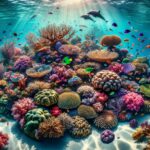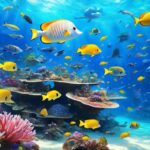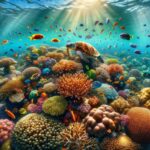Prepare to be amazed as we dive into the incredible world of ocean creatures! In this article, we’ll uncover 10 fascinating facts about these magnificent beings that call the deep sea home. From the mesmerizing adaptations of sharks to the stunning colors of coral reefs, we’ll explore the wonders of the deep and discover the incredible diversity of life that exists beneath the waves. So, grab your virtual snorkel and get ready for a journey filled with enchanting discoveries!
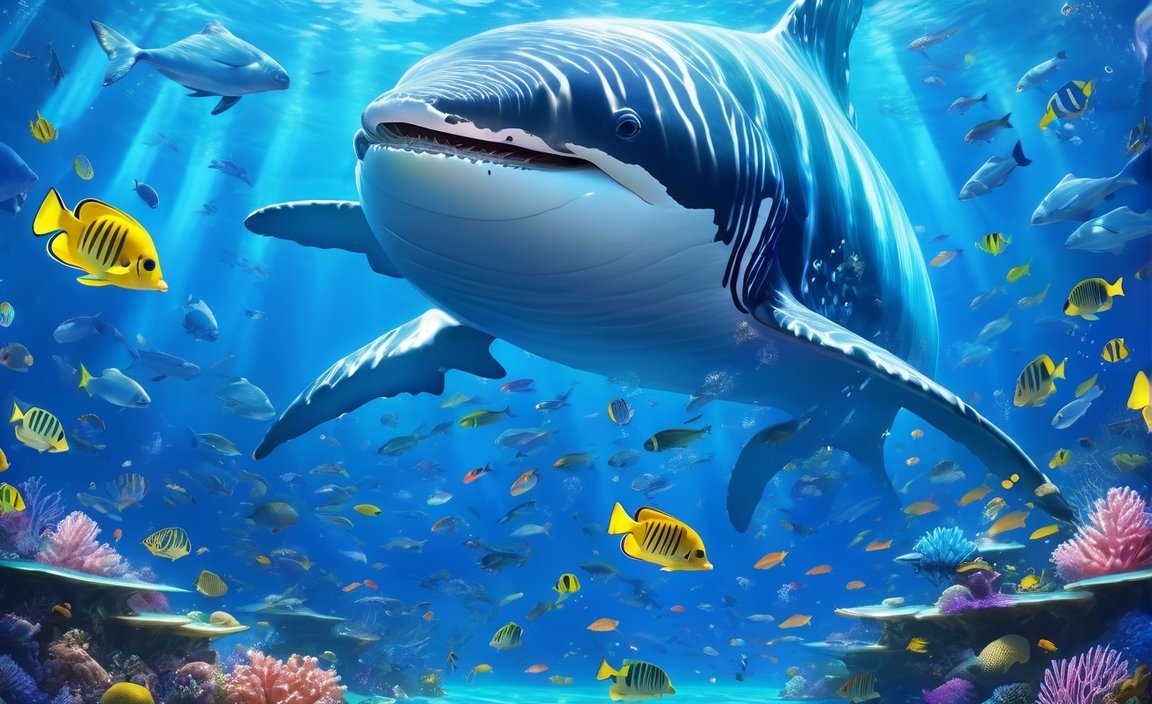
Key Takeaways:
- Some fish, like clownfish and wrasses, can change their gender in response to environmental factors or the absence of dominant individuals.
- The Paedocypris fish holds the record for being the smallest known vertebrate, growing to only about 8 millimeters in length.
- The whale shark is the largest fish, reaching up to 40 feet in length, despite being a gentle filter feeder.
- Octopuses have amazing camouflage skills, being able to change color and texture to match their surroundings.
- Sea cucumbers play a crucial role in marine ecosystems by feeding on organic debris and sediment, effectively recycling nutrients.
- Dolphins are highly intelligent creatures with complex social structures and communication skills.
- Male seahorses have a unique reproductive behavior, as they carry and give birth to their young.
- Coral reefs are incredibly biodiverse ecosystems, providing a habitat for around one-fourth of all marine species.
- Several turtle species found in U.S. waters, such as green turtles and leatherback turtles, are protected under the Endangered Species Act.
- Ocean currents govern global climate patterns, distributing heat around the planet and providing the necessary conditions for a diverse range of marine life to thrive.
10 Facts About Ocean Creatures
Ocean creatures are truly remarkable beings, showcasing a world of diversity and mystery beneath the surface. From the tiniest fish to the magnificent whales, these creatures possess extraordinary abilities and characteristics that captivate our imagination. Join us as we explore the wonders of the deep and discover these 10 fascinating facts about ocean creatures.
1. Gender-Bending Fish
Did you know that some fish have the ability to change their gender? Species like clownfish and wrasses can switch their gender in response to environmental factors or the absence of dominant individuals. This unique adaptation allows for better reproduction and survival in their dynamic underwater world.
2. The World’s Smallest Fish
In the peat swamps of Southeast Asia resides a tiny wonder: the Paedocypris fish. Measuring a mere 8 millimeters in length, this delicate creature holds the record for being the smallest known vertebrate. Its minuscule size makes it barely visible to the human eye, showcasing the vast diversity of ocean life.
3. The Gentle Giant: Whale Shark
Contrary to its fearsome reputation, the whale shark is a gentle giant of the ocean. Growing up to 40 feet in length, this magnificent creature primarily feeds on plankton and small fish as a filter feeder. Swimming alongside a whale shark is truly breathtaking, offering a glimpse into the beauty and grace of these enormous beings.
4. Masters of Camouflage: Octopuses
Octopuses possess incredible camouflage skills that are nothing short of mesmerizing. They have the ability to change both their color and texture, allowing them to blend seamlessly with their surroundings. By doing so, they become nearly invisible to predators and prey alike, showcasing nature’s extraordinary adaptability.
5. Sea Cucumbers: Ocean’s Vacuum Cleaners
In the depths of the ocean, sea cucumbers play a vital role as nature’s vacuum cleaners. These unique creatures feed on organic debris and sediment on the ocean floor, effectively recycling nutrients and maintaining the overall health of marine ecosystems. Their contribution highlights the delicate balance of life beneath the surface.
6. The Clever Cetaceans: Dolphins
Dolphins, known for their playful nature, also showcase remarkable intelligence. They exhibit complex problem-solving skills and possess intricate social structures. Communicating through a repertoire of clicks, whistles, and body movements, dolphins engage in a world we are only beginning to understand.
7. The Seahorse’s Unique Journey
Seahorses are captivating creatures, but what sets them apart is their unique reproductive behavior. In this species, it is the males who carry and give birth to the young. The female transfers her eggs to a pouch on the male’s belly, where he fertilizes them and provides care until they hatch, demonstrating nature’s diverse strategies for the continuation of life.
8. Coral Reefs: Biodiversity Hotspots
Coral reefs are not only breathtakingly beautiful but also serve as crucial habitats for a quarter of all marine life. These underwater ecosystems house an astonishing variety of species, making them vibrant hotspots of biodiversity. From vibrant fish to intricate invertebrates, coral reefs are truly captivating and worthy of protection.
9. Protecting Endangered Turtles
Turtles found in U.S. waters, such as green turtles, hawksbill turtles, and leatherback turtles, are protected by the Endangered Species Act. With the aim of conserving these incredible creatures, this legislation ensures their survival for future generations to enjoy. It reminds us of our responsibility to safeguard and cherish the wonders of the ocean.
10. Ocean Currents: Vital Life Support System
Ocean currents play a crucial role in governing not only global climate patterns but also supporting a kaleidoscope of life. They distribute heat around the planet, influencing weather patterns and transporting nutrients. These currents create the necessary conditions for a diverse array of marine life to thrive, showcasing the interconnectedness of the ocean and our world.
The world’s oceans continue to amaze us with their vast biodiversity and the captivating creatures that call them home. From the gender-bending fish to the delicate coral reefs, each fact about ocean creatures unveils a unique facet of nature’s ingenuity. So dive into the depths and let the wonders of the ocean enchant you.
Check out these 10 fascinating facts about the marine environment. Dive into the wonders of the ocean and discover how it shapes our planet and sustains life. To know more about the marine environment, click here.
Explore the intricate world of plant and animal cells with these 10 mind-blowing facts. Uncover the secrets of these microscopic powerhouses and their vital role in all living organisms. To delve deeper into the fascinating realm of cells, click here.
Immerse yourself in the captivating realm of sea life with these 10 incredible facts. From majestic whales to vibrant coral reefs, learn about the diversity and wonders that inhabit our oceans. Embark on an underwater adventure and click here to discover more.
Discover the untamed beauty of wild animals with these 10 astonishing facts. From the fastest land animals to the stealthiest predators, delve into the world of wildlife and uncover their remarkable adaptations. To get closer to nature, click here.
Adaptations of Ocean Creatures to Their Environment
Structural Adaptations
- Camouflage: Some ocean animals have developed remarkable camouflage abilities to blend in with their surroundings, making them nearly invisible to predators or prey. (Source: Oceanic Research – Adaptations for Survival in the Sea)
- Bioluminescence: Bioluminescence is a fascinating adaptation where organisms produce their own light, allowing them to communicate, attract mates, or distract predators. (Source: Smithsonian Ocean – The Deep Sea)
Physiological Adaptations
- Cold Water Tolerance: Many ocean creatures have adapted to survive in cold water by having specialized proteins that prevent ice crystal formation and maintaining a lower metabolic rate. (Source: Science Learning Hub – Marine organisms and adaptations)
- Pressure Resistance: Deep-sea organisms face extreme pressure in the abyssal zone. They have adapted by having flexible bodies, compressible air spaces, and specialized structures to withstand the crushing pressure. (Source: Geosciences LibreTexts – Adaptations to the Marine Environment)
Behavioral Adaptations
- Migration: Many ocean animals undertake long-distance migrations to find food, breed, or seek suitable environments. They have evolved navigation systems and energy-efficient swimming techniques for these journeys. (Source: National Geographic Society – All About the Ocean)
- Symbiotic Relationships: Ocean creatures often form symbiotic relationships with other species for mutual benefit. Examples include cleaner fish that remove parasites from larger fish or coral reefs that provide shelter and food for various organisms. (Source: SeaWorld San Diego Blog – Amazing Adaptations of Ocean Animals)
Key Takeaways:
– Ocean animals have remarkable adaptations to survive in their unique environments.
– Structural adaptations include camouflage and bioluminescence.
– Physiological adaptations include cold water tolerance and pressure resistance.
– Behavioral adaptations include migration and symbiotic relationships.
Sources:
– Oceanic Research – Adaptations for Survival in the Sea. (…)
– Smithsonian Ocean – The Deep Sea. (…)
Unique Behaviors Exhibited by Ocean Creatures
Ocean creatures are fascinating beings, with a wide variety of behaviors that have evolved to adapt to their unique environments. From the depths of the abyss to the vibrant coral reefs, these magnificent creatures exhibit truly remarkable and sometimes puzzling behaviors. In this article, we will explore 10 fascinating facts about the unique behaviors exhibited by ocean creatures.
Fact 1: “Nature’s Vacuum Cleaners”
Sea cucumbers, often overlooked for their peculiar appearance, play a vital role as nature’s vacuum cleaners. These fascinating creatures feed on organic debris and sediment on the ocean floor, effectively recycling nutrients and maintaining the health of their ecosystem[^1][^2].
Fact 2: Master of Camouflage
One of the most intriguing behaviors exhibited by ocean creatures is their ability to camouflage. Take the mesmerizing octopus, for example, with its incredible skills of changing color and texture to seamlessly blend with its surroundings. This adaptation helps them avoid predators and swiftly capture prey without being detected[^3].
Fact 3: “Glow in the Dark”
Bioluminescence, the production of light by living organisms, is a truly exceptional behavior found in some ocean creatures. Deep-sea organisms like anglerfish and certain species of plankton emit their own light, serving various purposes such as communication, attracting mates, or even distracting predators. Witnessing the enchanting glow of these creatures in the pitch-black depths is an otherworldly experience[^4].
Fact 4: “Master of Disguise”
The ocean is a realm of deception, where some creatures have taken disguise to a whole new level. The mesmerizing mimic octopus has the ability to imitate various marine animals, such as venomous lionfish or poisonous sea snakes, to deter potential predators and ensure its survival. This remarkable behavior showcases the incredible adaptability of ocean creatures[^3].
Fact 5: “Whale Songs in the Deep”
Communication among ocean creatures is a fascinating area of study. Whales, known for their hauntingly beautiful songs, have complex vocalizations that travel great distances underwater. These songs play a crucial role in mating rituals, navigation, and maintaining social bonds within their pods[^5].
Fact 6: “Mysterious Migrations”
Just like the Earth’s magnetic field guides us, some ocean creatures have evolved extraordinary navigation systems to undertake long-distance migrations. From the majestic humpback whales traveling thousands of miles to their breeding grounds, to tiny sea turtles finding their way back to the same beach where they were born, these migration journeys are truly awe-inspiring[^6].
Fact 7: “Cooperation in the Coral Reefs”
Coral reefs are not just vibrant ecosystems, but also hotspots for cooperation among ocean creatures. Cleaner fish, for example, form symbiotic relationships with larger fish by removing parasites from their bodies, providing a cleaning service with mutual benefits. Coral reefs themselves act as safe havens, offering shelter and food for countless marine species[^7].
Fact 8: “Masterful Tool Users”
Contrary to the misconception that tool use is exclusive to humans, some ocean creatures have also demonstrated remarkable skills in utilizing tools. One such example is the resourceful octopus, known to use coconut shells or other objects as makeshift shelters for protection[^8].
Fact 9: “Playful and Intelligent Dolphins”
Dolphins, often considered some of the most intelligent creatures in the ocean, exhibit complex problem-solving skills and engage in playful behavior. Their repertoire of clicks, whistles, and body movements represents a highly sophisticated communication system that allows them to coordinate hunting, navigate, and bond with their pod members[^9].
Fact 10: “Nature’s Marine Engineers”
Certain ocean creatures showcase impressive engineering skills. For example, the magnificent pufferfish uses its exceptional abilities to create intricate geometric patterns on the seafloor as part of its courtship display. These elaborate sand sculptures not only attract potential mates but also demonstrate the creative talents of these extraordinary creatures[^10].
Key Takeaways:
- Sea cucumbers play a crucial role as nature’s vacuum cleaners, feeding on organic debris and sediment on the ocean floor[^1][^2].
- Ocean creatures possess incredible camouflage abilities, allowing them to blend seamlessly with their surroundings for protection and hunting purposes[^3].
- Bioluminescence is a mesmerizing behavior exhibited by some ocean creatures, enabling them to emit their own light for communication and survival[^4].
- The mimic octopus astounds with its ability to imitate other marine animals as a defense mechanism[^3].
- Whales communicate through complex vocalizations, known as whale songs, to navigate, mate, and maintain social bonds within their pods[^5].
- Long-distance migrations undertaken by ocean creatures, such as humpback whales and sea turtles, are awe-inspiring examples of navigation skills[^6].
- Coral reefs foster cooperation among ocean creatures, such as cleaner fish removing parasites from larger fish, while providing shelter and food for various marine species[^7].
- Some ocean creatures, like the resourceful octopus, demonstrate tool-use skills, utilizing objects from the environment for protection or shelter[^8].
- Dolphins exhibit exceptional intelligence, problem-solving skills, and engage in playful behavior, communicating through a sophisticated system of clicks, whistles, and body movements[^9].
- Pufferfish showcase their engineering prowess by creating intricate sand sculptures on the seafloor as part of their courtship displays[^10].
Sources:
[^1]: All That’s Interesting
[^2]: Facts on Tap
Remember to explore and appreciate the wonders of the deep sea, as protecting our oceans and the unique behaviors exhibited by ocean creatures is crucial for the health and balance of marine ecosystems.
Threats Faced by Ocean Creatures and the Importance of Conservation Efforts
The world’s oceans are home to a vast array of incredible creatures, from tiny fish to majestic whales. However, these fascinating ocean dwellers face numerous threats that jeopardize their survival and the delicate balance of marine ecosystems. Understanding these threats and the importance of conservation efforts is crucial for preserving the wonders of the deep. So, let’s dive in and explore the challenges that ocean creatures face, and why conservation is more important than ever.
Overfishing: A Grave Threat to Ocean Life
One of the most significant threats to ocean creatures is overfishing. As demand for seafood increases, commercial fishing operations often exceed sustainable catch limits, severely depleting fish populations. This not only disrupts the delicate food chain but also affects the livelihoods of coastal communities dependent on fishing. [^1^]
Habitat Destruction and Climate Change
Ocean ecosystems are intricately linked to their habitats, such as coral reefs, mangroves, and seagrass beds. These habitats provide crucial breeding grounds, nurseries, and shelter for a wide variety of marine species. However, destructive practices such as trawling, dredging, and pollution are rapidly degrading these habitats, putting ocean creatures at risk. Furthermore, climate change and rising sea temperatures are causing coral bleaching and the loss of vital habitats. [^1^] [^2^]
Marine Pollution: A Silent but Deadly Threat
Pollution from various sources, including oil spills, plastic waste, and chemical runoff, poses a grave threat to ocean creatures. Marine animals can ingest or become entangled in plastic debris, leading to severe injuries or even death. Additionally, pollution disrupts the delicate balance of marine ecosystems, affecting the reproduction, development, and overall health of ocean creatures. [^1^]
Ocean Acidification: Alarming Changes in Chemistry
The absorption of carbon dioxide by the oceans is causing a phenomenon known as ocean acidification. This process alters the water’s chemistry, making it more acidic. Ocean acidification poses a significant threat to marine life, particularly organisms with calcium carbonate shells, such as corals, mollusks, and some plankton species. The increased acidity makes it challenging for these creatures to build and maintain their protective shells or skeletons, threatening their survival and the entire food web they support. [^1^] [^2^]
Loss of Biodiversity: A Disturbing Trend
The decline in ocean life due to various threats, including overfishing, habitat destruction, and pollution, is leading to a loss of biodiversity. This loss not only disrupts the delicate balance of marine ecosystems but also has far-reaching consequences for human well-being. Ocean creatures play a crucial role in maintaining healthy oceans, including carbon storage, nutrient cycling, and the provision of essential resources. Efforts to protect biodiversity are therefore crucial for the long-term health and sustainability of our oceans. [^1^] [^2^]
Importance of Conservation Efforts: Preserving Ocean Life
Conservation efforts are of paramount importance to ensure the survival of ocean creatures and the overall health of marine ecosystems. The establishment of marine parks and protected areas, combined with sustainable fishing practices, can help conserve biodiversity and protect vital habitats. Governments and organizations can play a pivotal role by implementing plans to map out priority areas for conservation, effectively managing fishing practices, and reducing harmful activities such as military sonar use. Conservation not only safeguards the wonders of the deep but also provides tangible benefits such as climate mitigation and food security. [^1^] [^2^]
Key Takeaways:
- Overfishing is a significant threat to ocean creatures, disrupting the food chain and affecting coastal communities.
- Habitat destruction, including practices like trawling and pollution, poses a grave risk to marine ecosystems and the creatures that rely on them.
- Pollution, such as plastic waste and oil spills, harms marine animals and disrupts the balance of ocean ecosystems.
- Ocean acidification, caused by the absorption of carbon dioxide, threatens the survival of organisms with calcium carbonate shells.
- The loss of biodiversity in the oceans due to various threats has far-reaching consequences for ecosystems and human well-being.
- Conservation efforts, including the establishment of marine parks and sustainable fishing practices, are crucial for preserving ocean life and the health of marine ecosystems.
Sources:
– National Geographic: Oceans and the Threats They Face
– BBC: Protect our ocean ‘to solve challenges of century’
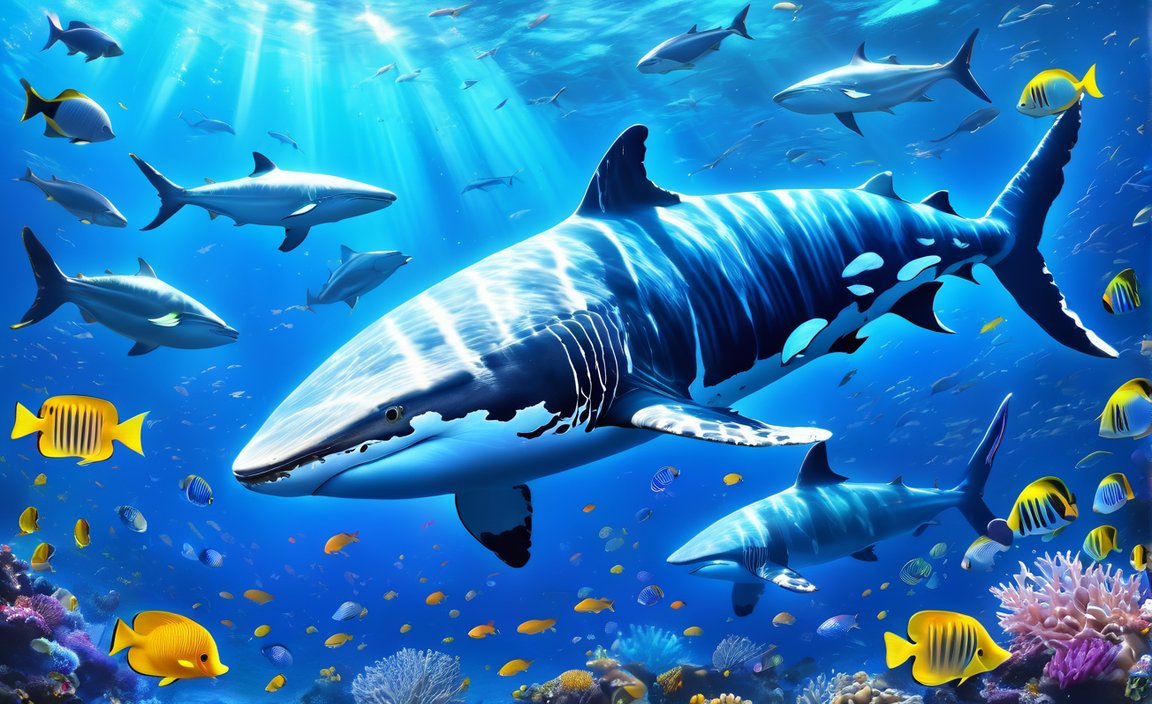
FAQ
Q1: How do fish change their gender in the ocean?
A1: Some species of fish, such as clownfish and wrasses, have the ability to change their gender in response to environmental factors or the absence of dominant individuals. This unique adaptation allows for better reproduction and survival in their dynamic underwater world.
Q2: What is the world’s smallest fish and where is it found?
A2: The world’s smallest fish is the Paedocypris fish, which is found in the peat swamps of Southeast Asia. Adults of this species grow to only about 8 millimeters in length, making them barely visible to the human eye.
Q3: How big can whale sharks grow and what do they eat?
A3: Whale sharks can grow up to 40 feet long. Despite their massive size, they are filter feeders, primarily feeding on plankton and small fish. Swimming alongside a whale shark is a breathtaking experience for divers and a testament to the beauty and grace of these enormous creatures.
Q4: How do octopuses change color and texture to match their surroundings?
A4: Some octopuses have special pigment cells called chromatophores in their skin that allow them to change color and texture. By manipulating these cells, octopuses can blend seamlessly with their surroundings, making them nearly invisible to predators and prey alike.
Q5: What is the role of sea cucumbers in marine ecosystems?
A5: Sea cucumbers act as the ocean’s vacuum cleaners. They feed on organic debris and sediment on the ocean floor, effectively recycling nutrients and enhancing the overall health of the ecosystem.
- China II Review: Delicious Food & Speedy Service - April 17, 2025
- Understand Virginia’s Flag: History & Debate - April 17, 2025
- Explore Long Island’s Map: Unique Regions & Insights - April 17, 2025

